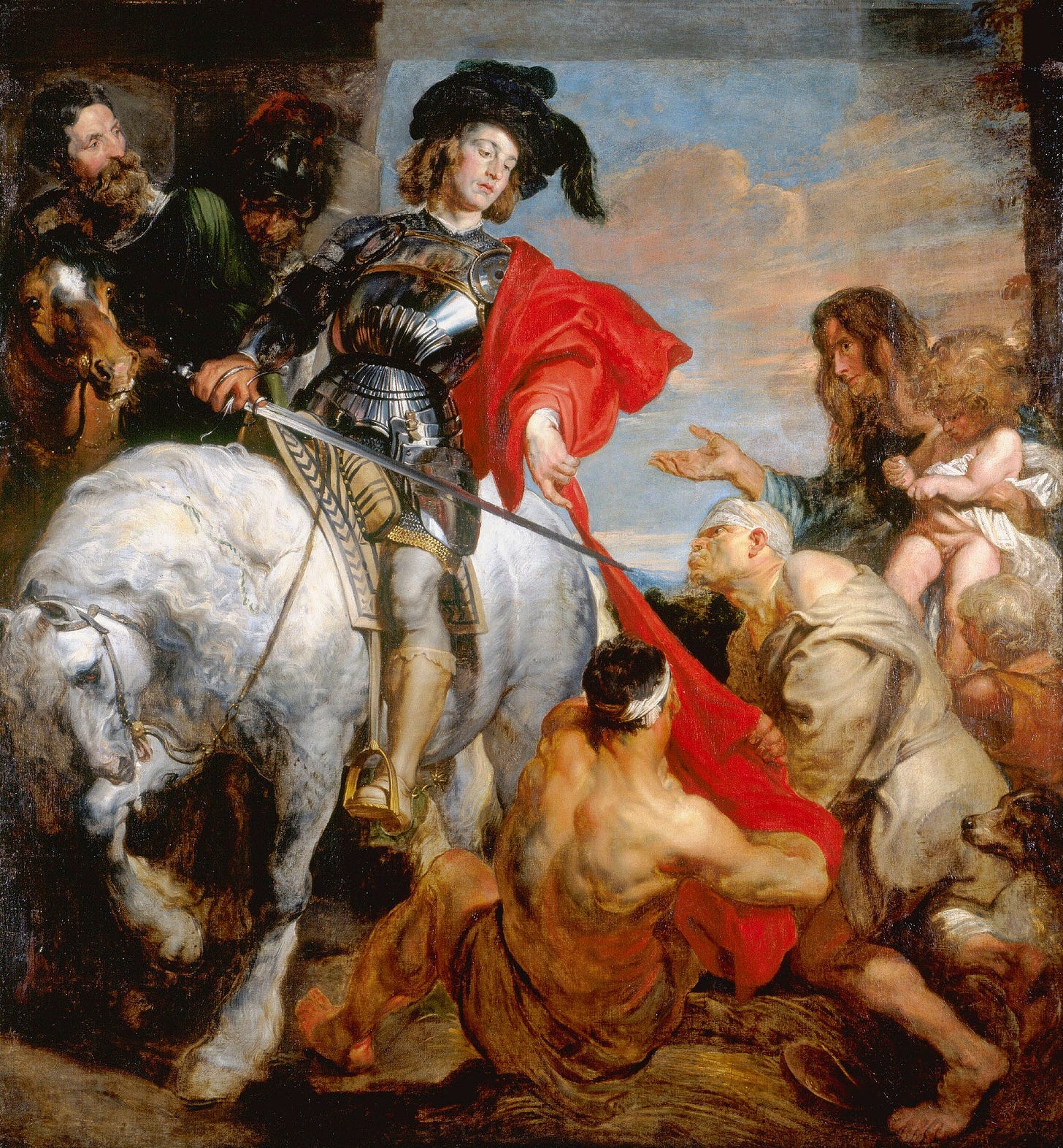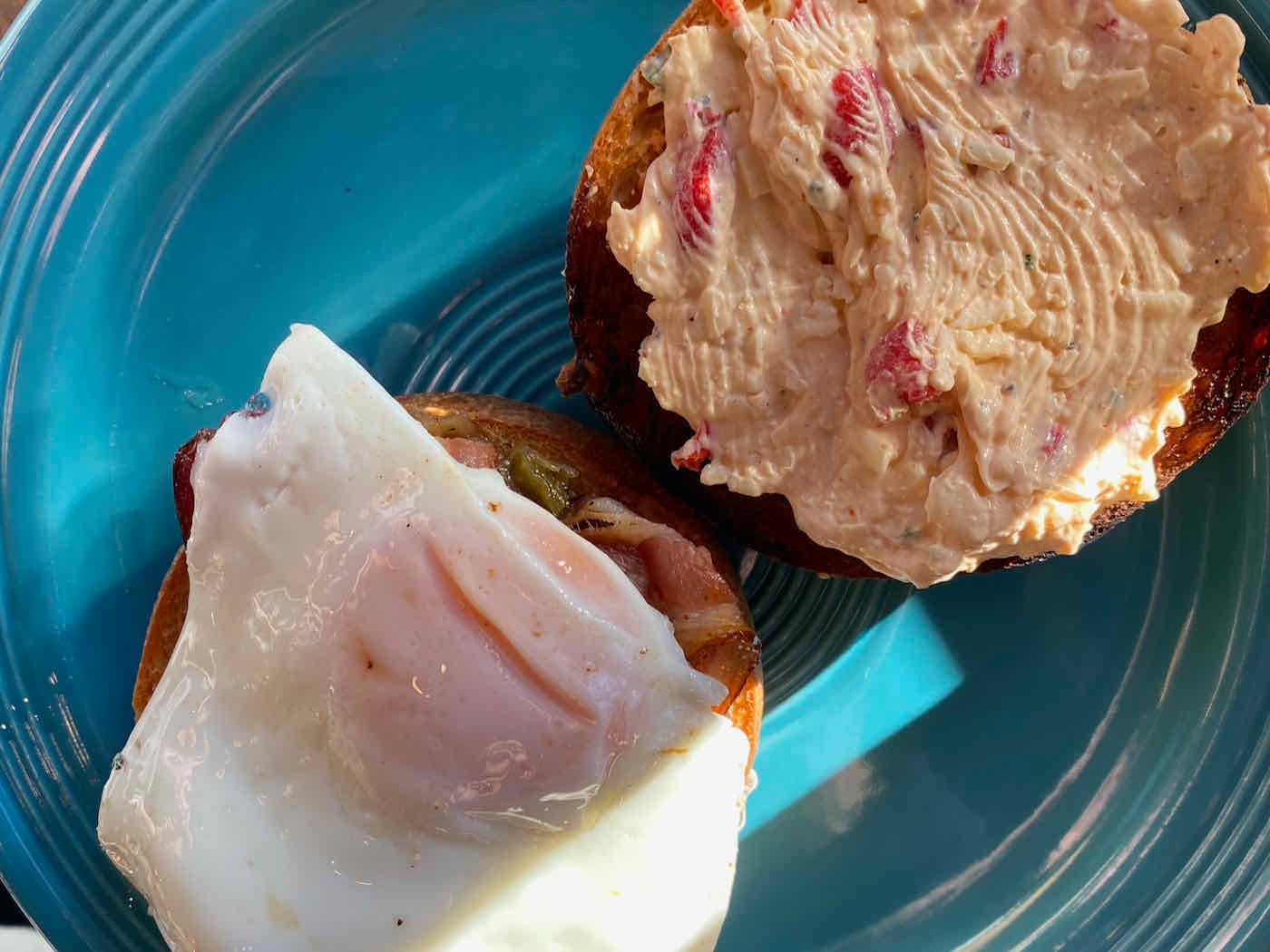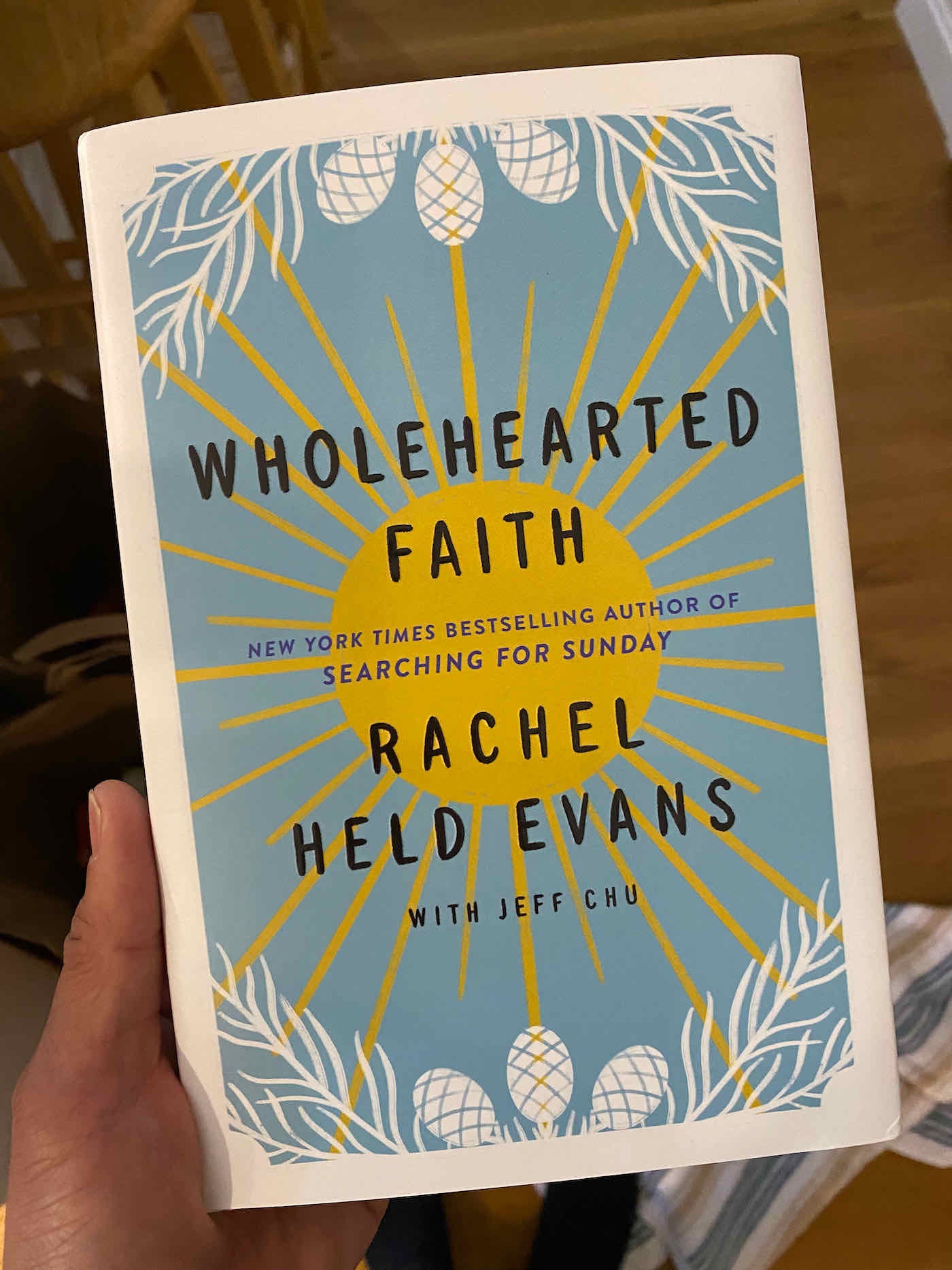Not So Fast
Some fragmented thoughts on the sprint toward Christmas, our need for Advent, the story of St. Martin of Tours, breakfast sandwiches, and Wholehearted Faith
Thursday, November 18
East Sandwich, Massachusetts
Greetings, friendly reader.
Here on Cape Cod, the past couple of weeks have brought a deluge of leaves—a crunchy carpet of browns and golds descending from on high as the trees prepare for winter. The days seem too short; the sun sets not long after we take Fozzie for his 4 p.m. walk. In the evenings, I crave the flavors of the fall: butternut squash soup, roast chicken, sweet potatoes, stewed greens (always better with bacon), caramelized pears.
Some people have already sprinted toward Christmas. Almost immediately after the Halloween candy went 50% off at the grocery store, I began to see post after post on social media: People were putting their Christmas decorations up. Christmas has to come early this year, they said. We need it.
What exactly do we need? Or, maybe more accurately, what exactly do we want?
I have no quibble with the wreaths or the trees, the candles in the windows or the tinsel, the glimmering lights or even the holiday soundtrack, especially if it’s Mariah Carey’s “All I Want for Christmas Is You,” and if you don’t think that is the best contemporary, nonreligious Christmas classic, well, fight me. I think all this represents our longing for rest and respite. We crave relief from the incessant march of bad news. We want some happy break from grim tidings—an endless pandemic, the deepening polarization, our utter failures as a society and as a world.
My suspicion, though, is that even a heavy dose of early Christmas cheer won’t really solve anything. If anything, the rush into enforced merriment is nothing more than standard-issue toxic positivity, wrapped in seasonally appropriate paper and tied up with a holiday bow. It will be an anesthetic, but not a cure. We might think we need a little Christmas right this very moment, but maybe the thing we could use is actually a longer Advent.
To some, this might seem a distinction without a difference. But Advent matters, because it compels us to wrestle with our reality before we tuck into the Christmas feast. Advent, a word derived from the Latin adventus, meaning “coming,” is a time set apart for holy waiting and careful examination. If Christmas is about the coming of salvation, embodied in the baby Jesus, isn’t it worth contemplating what we’re being saved from? And if Christmas means welcoming our long-awaited Emmanuel—“God with us”—doesn’t that mean we’re called to play some part in the healing, since it’s God with us?
In most churches that mark Advent nowadays, the liturgical season has been compressed into four Sundays, starting after Thanksgiving, even as pre-Christmas festivities have mounted. In some strains of Christianity, including much of the Baptist tradition of my upbringing, Advent has disappeared altogether. Centuries ago, though, it was longer. It would have begun last week, right after the Feast of St. Martin, which falls on November 11. And it meant more to the pious—indeed, asked more of them—than several Sundays of special worship services with seasonal anthems from the choir and a return to familiar passages of Scripture.
St. Martin was a Roman soldier in the 4th century. The son of a Roman officer, he was destined for military service, but though his parents were not Christians, he felt a pull to the Church. According to his hagiography, he wanted to become a monk, and as a child, he registered as a catechumen. Before he could be baptized, though, he followed his father into the military and was sent to Gaul. Just before a battle in what is now Germany, he felt compelled to surrender his sword. “I am the soldier of Christ,” he reportedly said. “It is not lawful for me to fight.”

Martin’s superiors jailed him on charges of cowardice. After his release, he finally took a monk’s vows. He then devoted his life to evangelism and particularly to mercy ministries; prison wardens came to dread his arrival, because inevitably he would plead for the release of prisoners.
In those days, it was customary for the people of the Church, not the ecclesiastical hierarchy, to nominate bishops; can you imagine? The story goes that the faithful of the French city of Tours, eager for this holy man to become their bishop, cunningly targeted his pastoral soft spot: They lured him to town by claiming that a sick man needed healing. When Martin discovered their true goals, he hid amidst a flock of geese. This was surely a sign of his foolishness: The birds quickly announced his presence. Whether or not he interpreted this as nature’s affirmation of his unwanted call or not, we can’t know. But he did then accept the bishopric. But he maintained an ascetic reputation as well as his emphasis on ministry to the needy. His renown was so great that he was recognized as a saint within 80 years of his death.
On St. Martin’s feast day, meat was roasted—often, of course, goose—and the wine flowed, because Martin was known not only for establishing churches and monasteries but also for planting vineyards, which he saw as necessary for the Eucharist. Through the Middle Ages, Martinmas marked the harvest’s official end. Afterward, the pious fasted three times a week to prepare for Christmas—a mini-Lent.
A mini-Lent is obviously not what most people want right now. We’re nearing that time of year when, if you don’t exude Christmas cheer from every pore, you’re outing yourself as a Scrooge. [Jeff raises his hand.]
Well, here’s the thing about Scrooge: he might unwittingly have been onto something with his Bah, humbug. I didn’t know what “humbug” meant until I looked it up last week. A humbug is a trick, a deception—and to jump to Christmas without walking through Advent is spiritual sleight of hand that hurts us all. The salvation that Christmas brings is as joyous as it is only if we understand the depth of our need for its saving grace, and Advent urges us to reflect on all that needs to be redeemed. I wonder whether a return to a robust Advent might shift us toward a more active and indeed Martin-like posture, such that the griefs and sorrows of the world move not just our hearts and our lips but also our hands and our feet.
As I’ve read about St. Martin, I’ve been struck repeatedly by his steadfast refusal to turn away from the world’s aches and wails: Even after becoming bishop, he remained a pastor at heart, visiting every single parish in his diocese at least once a year. He devoted himself to prayer. He advocated relentlessly for the healing of the sick, for freedom for the captives, for peace in a war-weary world. After his death, he became a patron saint of the poor.
It seems fitting that the feast day of a man who laid down his sword so that he could take up his cross should usher in Advent, when we are called to contemplate all that yearns for healing, all that cries out for redemption. Advent “is the season of an ever-growing and ever-kindly light—the one that lets us see reality more clearly,” my friend Kate Bowler writes in her beautiful Advent devotional, “The Season of Almost.” “Advent is preparation for the great inversion: God coming to Earth in the form of a baby; the ruler of the cosmos trapped in a squalling package of helpless flesh. He was born to save us—and he will—but first he must melt our hearts, appearing not as a sage or a philosopher or an emperor but as a cold little child with no home.” (You can download Kate’s devotional for free.)
We’re almost there, but not quite yet. So let us turn toward the light—not rushing, not getting lost in the pre-holiday fervor, not being swept up by the busyness or by our lust for cheer. May our hearts turn soft and our spirits tender, and may we see reality more clearly every day.
What I’m Eating—and Cooking: Tristan and I went to Charleston last weekend to celebrate a friend who recently had a big birthday. Maybe we accidentally marked Martinmas: We ate so many outstanding and indulgent meals that, by Sunday, I just wanted a simple dish of vegetables.
At the Daily, which specializes in breakfast and lunch, my heart leapt after a bite of its Bacon Breakfast Sandwich.
This got me to thinking about how breakfast is an under-appreciated meal—and the breakfast sandwich an under-appreciated culinary genre. An outstanding breakfast sandwich represents the convergence of a number of key elements, flavors and textures melding to produce a morning aria.
Take the Daily’s Bacon Breakfast Sandwich: The bacon provides the perfect crispy counterpoint to the over-easy egg and the toasted, yet still pillowy brioche bun. The pimento cheese adds savory goodness, along with the caramelized onion and jalapeño jam. (One day, alas, the bacon was slightly flabby sadness, but the sandwich was still delicious. Yes, we went there twice. Yes, I had the sandwich twice.)
Tristan and I recently reminisced about favorite breakfast sandwiches. He controversially mentioned El Primo, a beloved breakfast-taco stop in Austin, Texas. Which led to an interesting question: Is a taco a sandwich? Opinions welcome.
Eggslut, which has locations in Los Angeles and Las Vegas, is a temple to the form. Its sandwiches are elevated by outstanding condiments—chipotle ketchup on the bacon, egg, and cheese, for instance, and honey mustard aioli on the sausage version.
New York City imprinted a love for the bagel sandwich on my stomach; I’ll always adore an unfussy B-E-and-C on a toasted everything bagel. The crunchy, chewy bagel reminds you that this is no bougie brioche, no ordinary white bread. While some places do an omelet-style egg—less messy—I prefer a fried egg, over easy, so that the yolk breaks to create a sauce.
Please don’t think I’m a snob about breakfast sandwiches or even how my eggs are cooked: I love an Egg McMuffin at McDonald’s. I usually ask to substitute normal bacon for Canadian bacon; no offense to Canada, but it’s just better that way.
One of the best breakfast sandwiches I’ve ever had is the Sunday Sandwich at Amy’s Place, in Providence, Rhode Island. This sandwich is ridiculous. Of course there’s a fried egg. And cheese. Bacon brings crunch, as does the crispy hash brown. Who puts hash browns in a sandwich? Well, we all should, because it is amazing. Guacamole adds lusciousness, the spicy aioli a needed kick, and the greens and the tomato some fresh relief. And it all comes on a bolo—a roll that is the English muffin’s slightly sweeter Portuguese cousin.
One beautiful thing about a breakfast sandwich is that it’s not difficult to make a good one at home. The basic ingredients are neither expensive nor arcane. You want some fat, some crunch, some salt, some contrast, and you might want some spice; how you achieve your ideal combination is really up to you. If you go with a simple, vegetarian egg and cheese, I’d choose a sharp, aged cheddar or a smoked gouda, I’d make sure whatever bread you use is toasted well, so that it’s not just soft-on-soft-on-soft, and I’d add some hot sauce (Yellowbird’s habanero is a favorite in our kitchen). If you have a tender, flaky buttermilk biscuit, then make sure your bacon is extra-crispy—and just a bit of honey or maple syrup might bring a welcome touch of sweetness.
Do you have a favorite breakfast sandwich? I’d love to know what it is.
Finally, I want to express my gratitude to those of you who have remembered me, Dan Evans, and Rachel Held Evans’s family in your prayers, sent your good wishes and encouragement, and cheered us on as we put Wholehearted Faith, Rachel’s final book for adults out into the world. Your support has meant more than you could ever know.
The response to the book has been overwhelming. Eliza Griswold did a beautiful story about Rachel’s legacy for The New Yorker, Elizabeth Dias of the New York Times talked with Dan and me for the Sunday paper, NPR’s Sarah McCammon asked such heartfelt questions, and my friend Sarah Bessey wrote a gorgeous reflection. In its first week, Wholehearted Faith made two of the New York Times’s best-seller lists, which was tremendously bittersweet. Dan told me that Rachel had never made the hardcover nonfiction list before. We wish she were here to witness it.
For me, the truly gratifying thing has been to see how, as people have read the book, they’ve found something in its pages that meets them where they are. Rachel’s expansive vision of God’s love has helped readers feel loved, and it has been the honor of my life to get to amplify that into a world that so desperately could use just a little more goodness, a little more hope, and a little more love.
If you’ve bought Wholehearted Faith, thank you. If you’ve read it, I’d love to know what you thought, what questions it might have raised for you, or whether there was anything that did not sit right with you. All feedback is welcome.
Now that most of the work around the book is done—though you can still join us on Instagram, where the @wholeheartedfaithbookclub is going strong—I hope to be more consistent in my own writing. As always, I’m so glad we can stumble through all this together, and I’ll try to write again soon.
Much love,
Jeff





you are remarkable. soSO grateful for your life, your work, Fozzie and Tristan. Wishing you a blessed Thanksgiving, Advent and Christmas…I learn so much from you.
I've been thinking a lot about a longer Advent this month, so this felt like inevitable reading today, but my wife promptly ruined my Deep Thinking, when I read her the bit about Martin and the geese out loud, and she asked me if he'd cooked his goose, said maybe she'd take a gander at your post, and then apologized for her fowl humor. I promise I gave her a very stern look.
I am now a NYC expat in Canada and nobody here has a proper kaiser roll, which is my preferred vehicle for a sausage egg & cheese. The bagels here are too small with too large of a hole, and the rolls are too soft, missing that proper crust. I'm already planning on eating too many egg sandwiches on my next visit home, and probably also just a bunch of plain buttered kaisers as well. And then filling my suitcase with some to bring back and freeze.